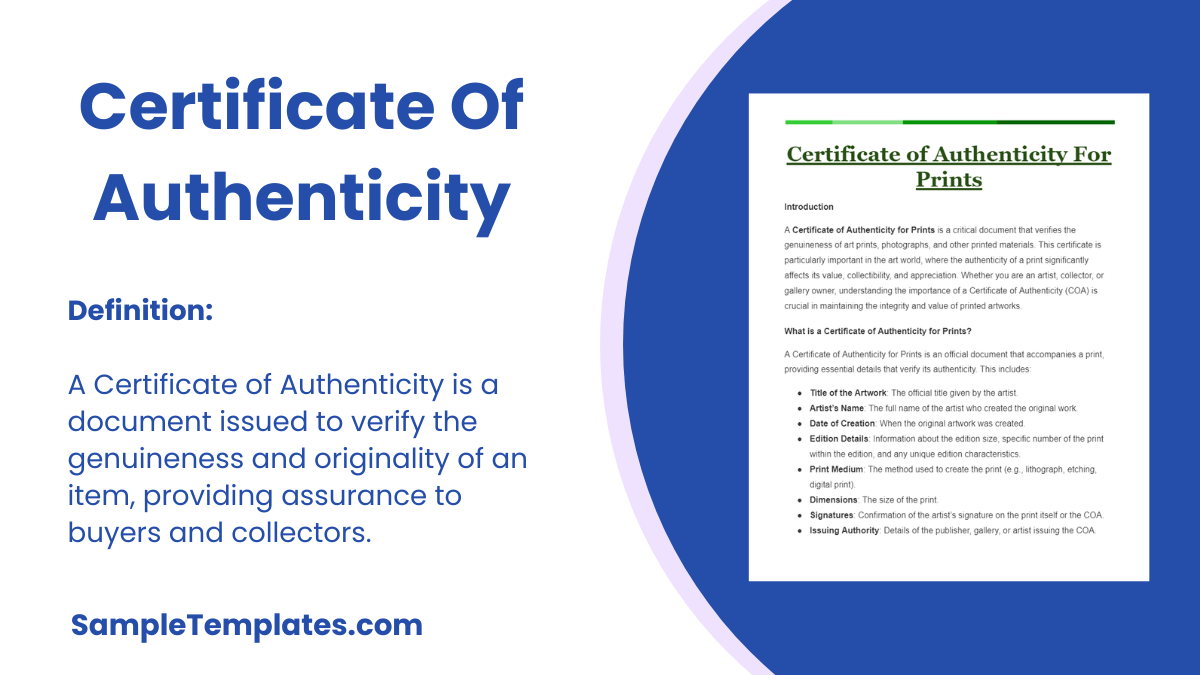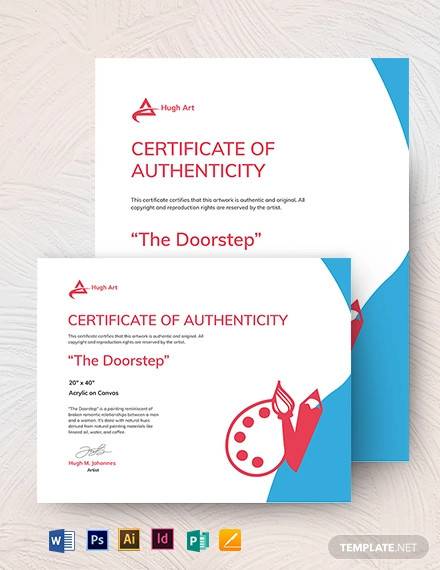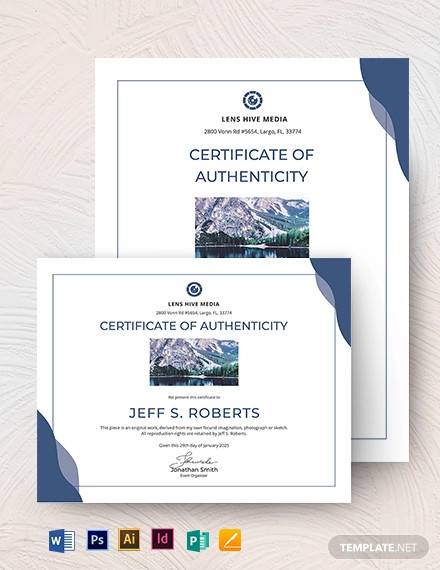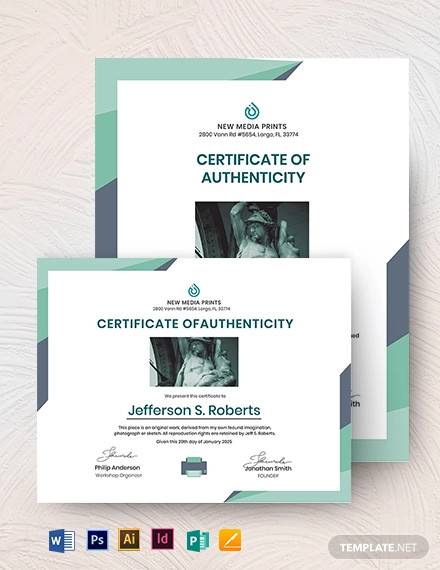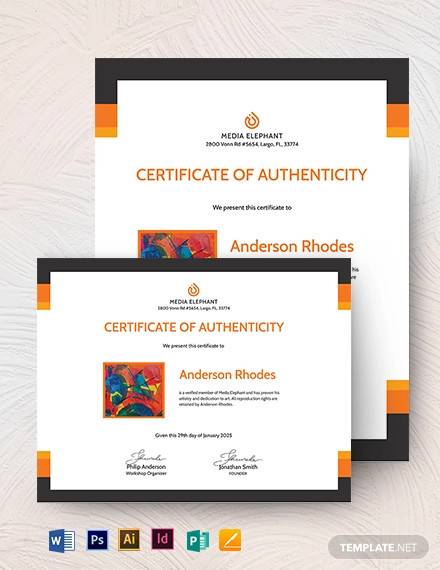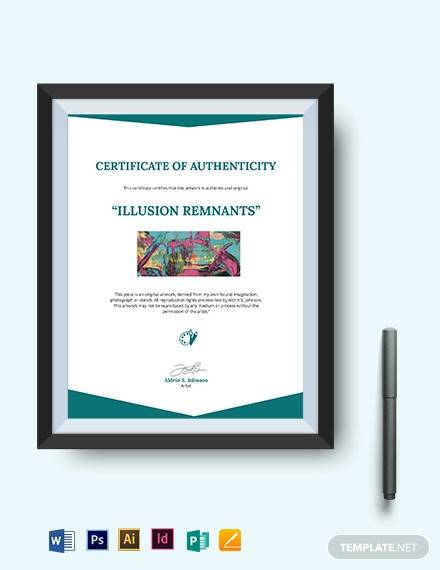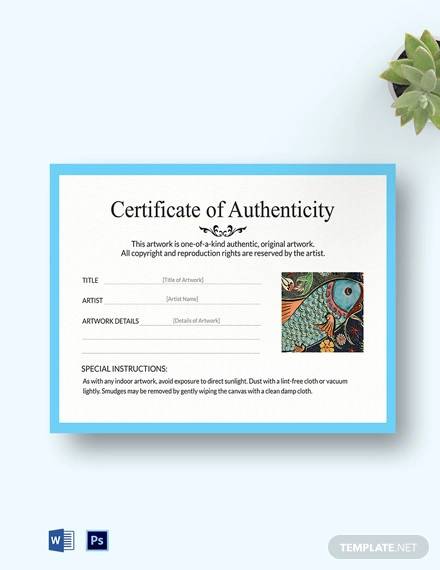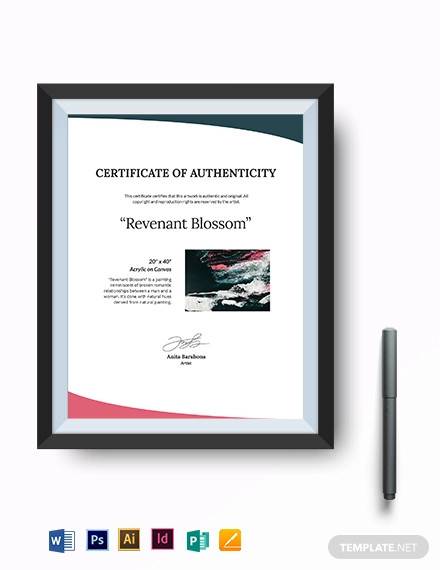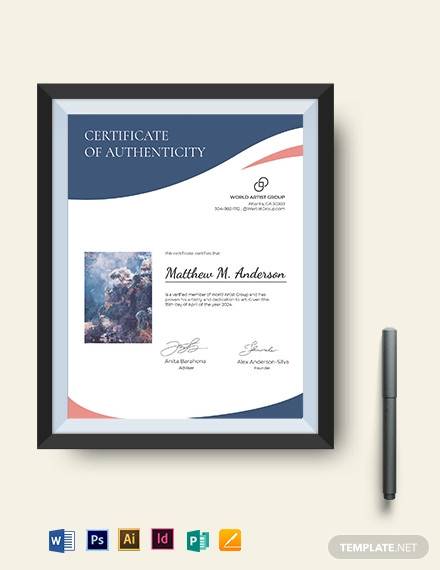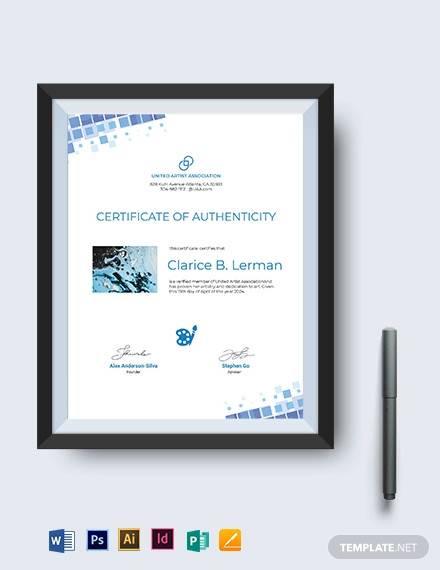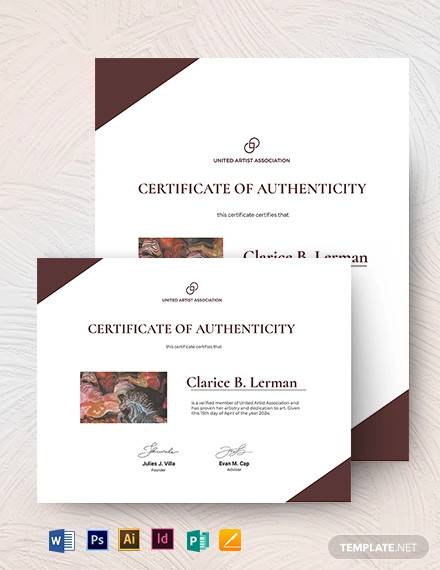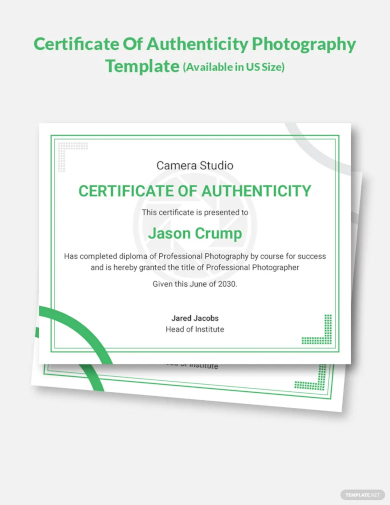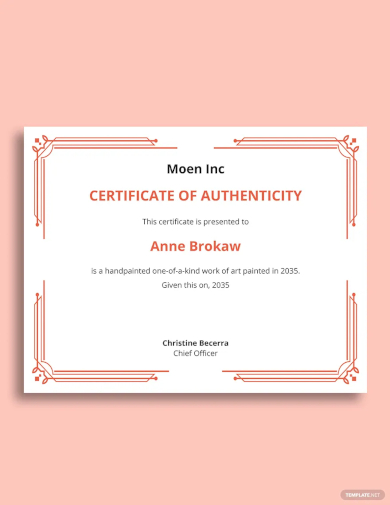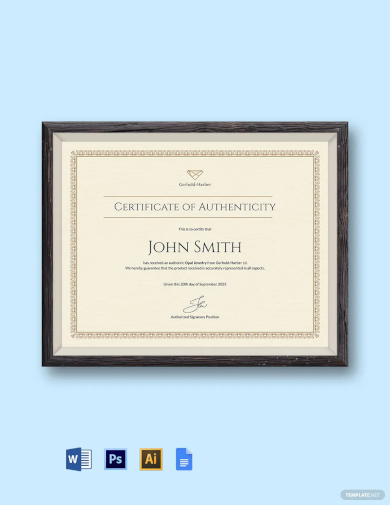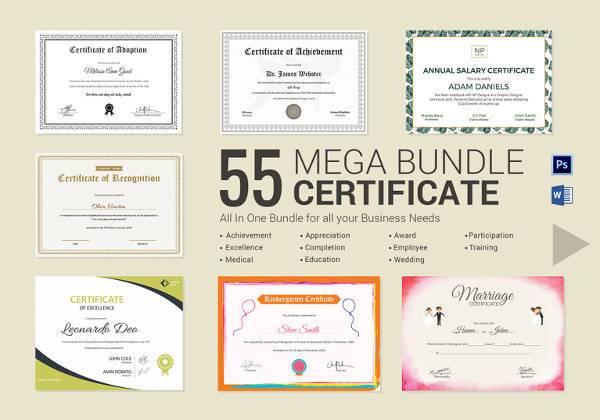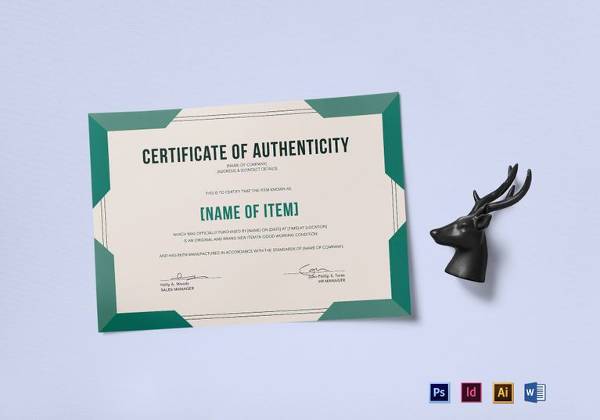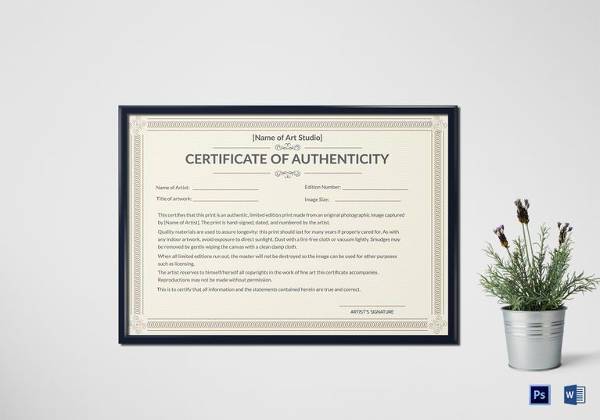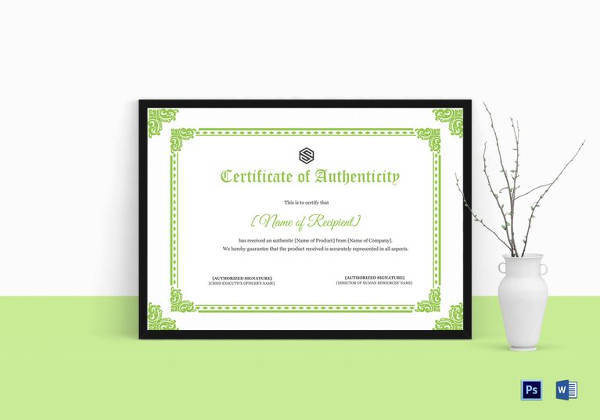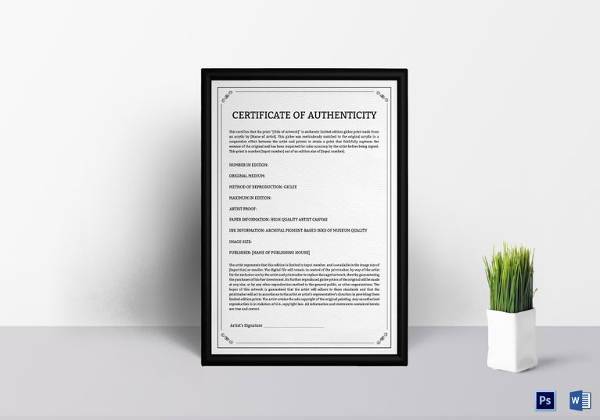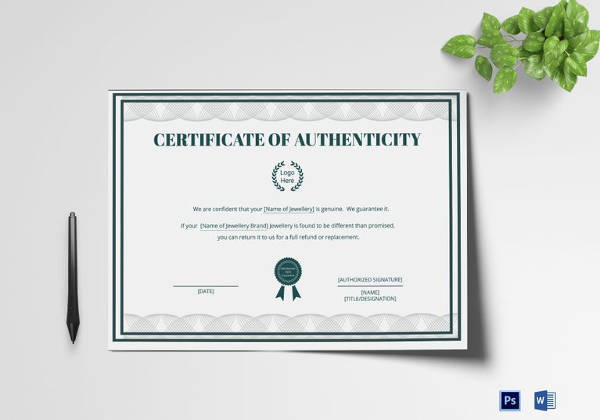The human brain works wonders when it comes to creating new technology, artwork, and theories. Through simple ideas, inventors make better machines to help thousands of people. However, some people might have the same concept but with different intentions. In this case, individuals have to prove that they are the original creators of the material. Besides intellectual property agreements and trademark registrations, people also need a sample certificate of authenticity. Learn more about this useful tool by reading this well-detailed article.
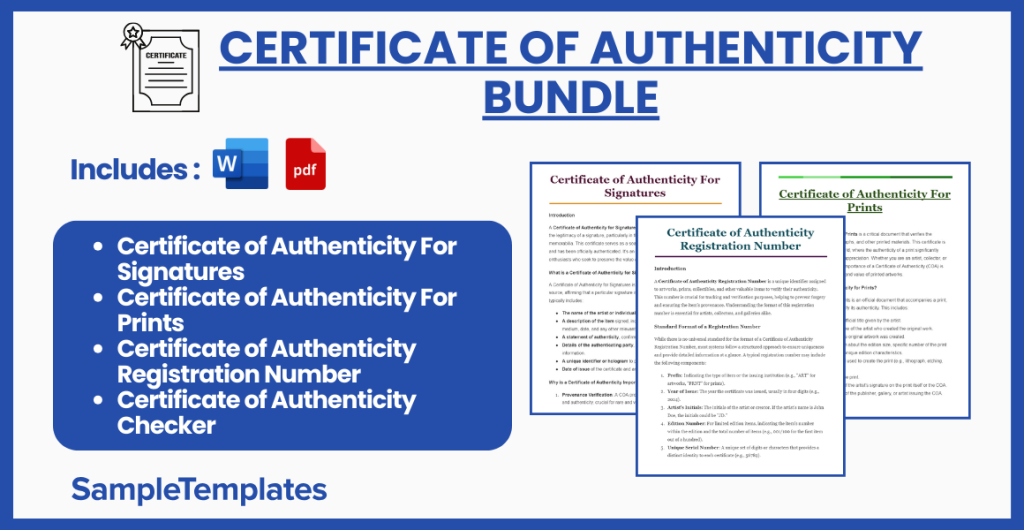
Download Certificate of Authenticity Bundle
Certificate of Authenticity For Signatures
Introduction
A Certificate of Authenticity for Signatures (COA) is a vital document that attests to the legitimacy of a signature, particularly in the context of artworks, collectibles, and memorabilia. This certificate serves as a seal of verification that the signature is genuine and has been officially authenticated. It’s an essential tool for collectors, investors, and enthusiasts who seek to preserve the value and integrity of signed items.
What is a Certificate of Authenticity for Signatures?
A Certificate of Authenticity for Signatures is a formal document provided by a reputable source, affirming that a particular signature is authentic and genuine. This document typically includes:
- The name of the artist or individual whose signature is being authenticated.
- A description of the item signed, including details such as dimensions, medium, date, and any other relevant information.
- A statement of authenticity, confirming the signature is original and legitimate.
- Details of the authenticating party, including their credentials and contact information.
- A unique identifier or hologram to prevent forgery of the COA itself.
- Date of issue of the certificate and any relevant serial numbers.
Why is a Certificate of Authenticity Important?
- Provenance Verification: A COA provides a documented lineage of ownership and authenticity, crucial for rare and valuable items.
- Value Preservation: Authentic items often have significantly higher value. A COA ensures that this value is recognized and maintained.
- Trust in Transactions: In buying and selling signed items, a COA is a trust-building tool that assures buyers of the item’s legitimacy.
- Legal Protection: In disputes regarding authenticity, a COA can serve as a legal document that substantiates the item’s genuineness.
Obtaining a Certificate of Authenticity
Obtaining a COA involves verification from a qualified authenticator or authentication company. The process typically includes:
- Research and Verification: The authenticator examines the signature, often using historical records, signature databases, and expert analysis.
- Physical Inspection: For tangible items, a detailed inspection is conducted to assess the signature’s age, materials, and technique.
- Documentation and Issuance: Once authenticated, the COA is issued, detailing the item’s authenticity and providing peace of mind to all parties involved.
Conclusion
A Certificate of Authenticity for Signatures is indispensable in the world of collectibles and memorabilia. It not only serves to verify the authenticity of a signature but also plays a crucial role in preserving the item’s value, ensuring trust in transactions, and providing legal protection. Whether you are a collector, an investor, or a fan, ensuring that your signed items come with a COA is a step towards safeguarding your investment and interests.
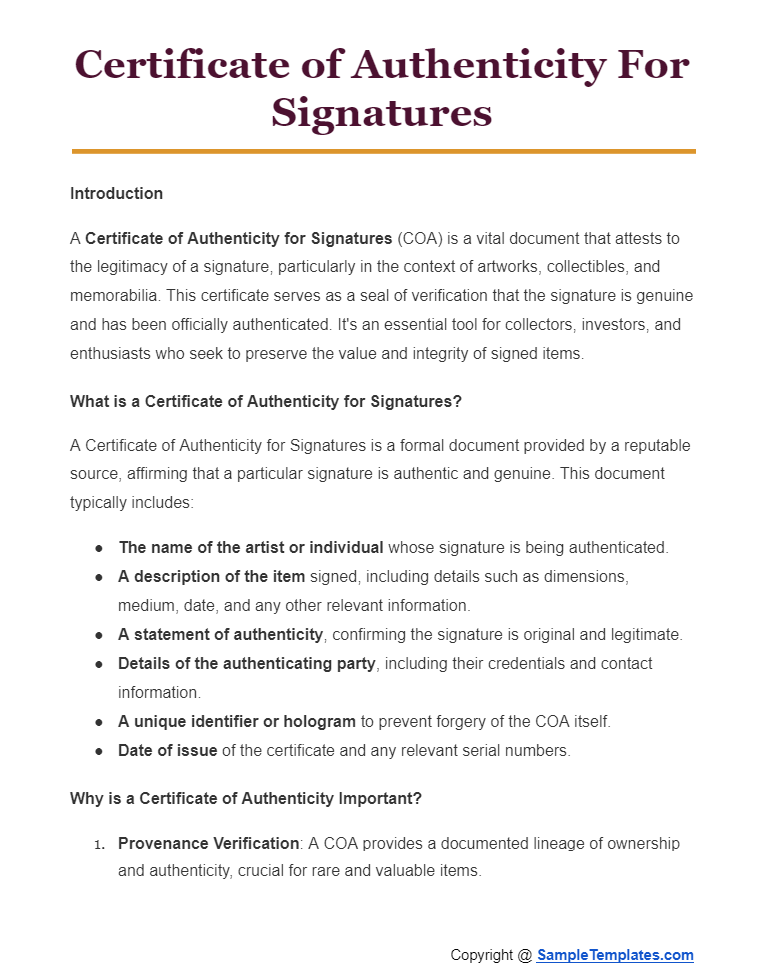
Certificate of Authenticity For Prints
Introduction
A Certificate of Authenticity for Prints is a critical document that verifies the genuineness of art prints, photographs, and other printed materials. This certificate is particularly important in the art world, where the authenticity of a print significantly affects its value, collectibility, and appreciation. Whether you are an artist, collector, or gallery owner, understanding the importance of a Certificate of Authenticity (COA) is crucial in maintaining the integrity and value of printed artworks.
What is a Certificate of Authenticity for Prints?
A Certificate of Authenticity for Prints is an official document that accompanies a print, providing essential details that verify its authenticity. This includes:
- Title of the Artwork: The official title given by the artist.
- Artist’s Name: The full name of the artist who created the original work.
- Date of Creation: When the original artwork was created.
- Edition Details: Information about the edition size, specific number of the print within the edition, and any unique edition characteristics.
- Print Medium: The method used to create the print (e.g., lithograph, etching, digital print).
- Dimensions: The size of the print.
- Signatures: Confirmation of the artist’s signature on the print itself or the COA.
- Issuing Authority: Details of the publisher, gallery, or artist issuing the COA.
- Security Features: Any holograms, watermarks, or unique identifiers to prevent forgery.
Why is a Certificate of Authenticity Important for Prints?
- Verifies Authenticity: A COA is a proof that the print is authorized by the artist or the representing entity, distinguishing it from unauthorized reproductions.
- Protects Value: Authentic prints often hold or increase in value over time. A COA is essential in establishing this value in the market.
- Enhances Collectibility: Collectors prioritize prints with a clear, verifiable provenance. A COA provides this provenance, making the print more desirable.
- Facilitates Resale: Selling prints with a COA is easier, as potential buyers feel more confident in the legitimacy and value of their purchase.
- Preserves Artist’s Legacy: For artists, issuing a COA with their prints helps in maintaining the integrity and intended presentation of their work.
Obtaining a Certificate of Authenticity
To obtain a COA for a print:
- From Artists: Artists can create their own COA for limited edition prints, including all relevant details and signatures.
- Through Galleries: When purchasing through a gallery, ensure that they provide a COA with the artwork.
- Via Authentication Services: For previously acquired prints, professional authentication services can issue a COA after verifying the artwork’s authenticity.
Conclusion
A Certificate of Authenticity for Prints is indispensable for anyone involved in the creation, collection, or sale of printed artworks. It not only serves as a testament to the print’s authenticity but also plays a vital role in protecting the artwork’s value, enhancing its collectibility, and facilitating its resale. Ensuring that your prints are accompanied by a valid COA is a step towards safeguarding the art’s integrity and ensuring its appreciation over time.

Certificate of Authenticity Registration Number
Introduction
A Certificate of Authenticity Registration Number is a unique identifier assigned to artworks, prints, collectibles, and other valuable items to verify their authenticity. This number is crucial for tracking and verification purposes, helping to prevent forgery and ensuring the item’s provenance. Understanding the format of this registration number is essential for artists, collectors, and galleries alike.
Standard Format of a Registration Number
While there is no universal standard for the format of a Certificate of Authenticity Registration Number, most systems follow a structured approach to ensure uniqueness and provide detailed information at a glance. A typical registration number may include the following components:
- Prefix: Indicating the type of item or the issuing institution (e.g., “ART” for artworks, “PRNT” for prints).
- Year of Issue: The year the certificate was issued, usually in four digits (e.g., 2024).
- Artist’s Initials: The initials of the artist or creator. If the artist’s name is John Doe, the initials could be “JD.”
- Edition Number: For limited edition items, indicating the item’s number within the edition and the total number of items (e.g., 001/100 for the first item out of a hundred).
- Unique Serial Number: A unique set of digits or characters that provides a distinct identity to each certificate (e.g., 56789).
Example Formats
Given these components, a Certificate of Authenticity Registration Number could take various forms, depending on the specific practices of an artist, gallery, or institution. Here are a few examples:
- ART-2024-JD-001/100-56789
- PRNT2024JD10056789
- 2024-JD-PRNT-001/100-56789
Key Considerations
- Uniqueness: Each registration number must be unique to prevent duplication and ensure the authenticity of each item.
- Consistency: Using a consistent format makes it easier to manage and verify the authenticity of items, especially for artists or institutions with large volumes of work.
- Security Features: In addition to the registration number, certificates often include other security features like holograms, watermarks, or QR codes to further authenticate the document.
Conclusion
The Certificate of Authenticity Registration Number plays a critical role in the art and collectibles markets, providing a reliable method for verifying the authenticity and provenance of valuable items. While the format can vary, the inclusion of key elements like the prefix, year of issue, artist’s initials, edition number, and a unique serial number is common practice. Whether you are an artist issuing a certificate or a collector verifying an item’s authenticity, understanding the format and importance of the registration number is essential.
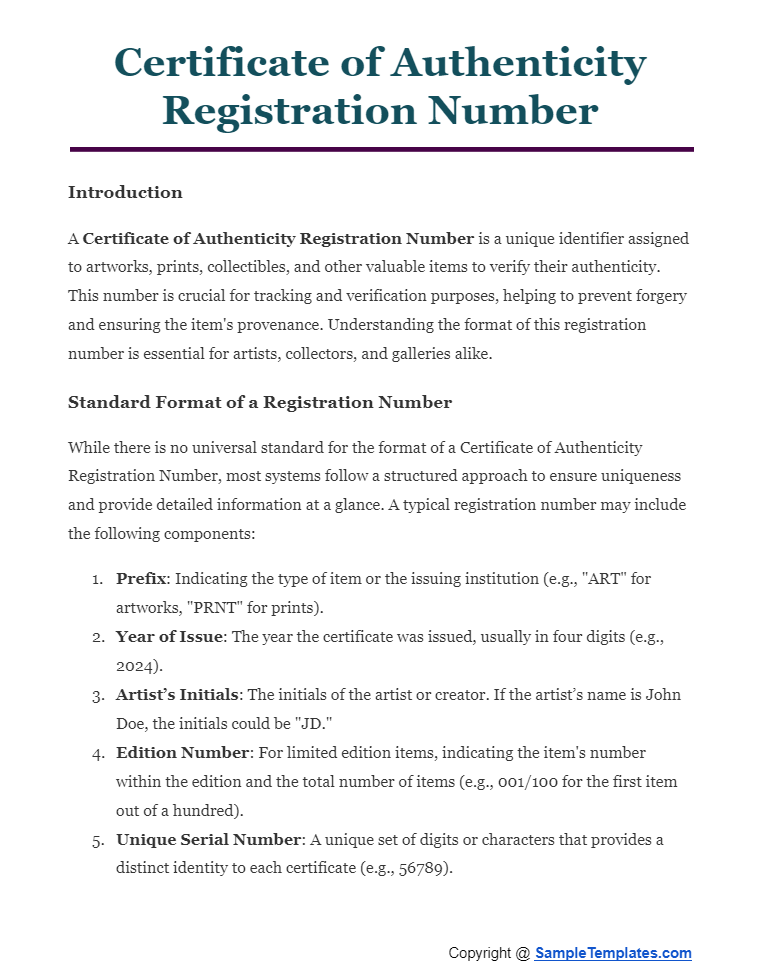
Certificate of Authenticity Checker
Introduction
A Certificate of Authenticity Checker is an invaluable tool for artists, collectors, galleries, and buyers to verify the authenticity of artworks, prints, and collectibles. This digital tool or system cross-references the details of a Certificate of Authenticity (COA) against a database to confirm its validity. Understanding the format and components required for verification can streamline the process, ensuring accuracy and reliability.
Essential Information for Verification
For a Certificate of Authenticity Checker to effectively verify the authenticity of an item, certain information must be provided. The format generally includes:
- Registration Number: The unique identifier assigned to the COA, which is critical for verification.
- Artist or Creator Name: The full name of the artist or creator of the item.
- Item Description: Detailed information about the item, including title, creation date, medium, dimensions, and edition (if applicable).
- Issue Date of COA: The date when the COA was issued.
- Issuing Authority: Information about the entity that issued the COA, such as an artist, gallery, or authentication service.
- Security Features: Details of any security features included on the COA, like holograms, QR codes, or watermarks.
Format for Submitting Information
When using a Certificate of Authenticity Checker, you will typically be prompted to enter the following information in a structured format, such as an online form or database query. Here’s an example format for submitting information:
- Registration Number: [Enter Registration Number]
- Artist or Creator Name: [Enter Artist’s Full Name]
- Item Description:
- Title: [Enter Title of Artwork/Item]
- Creation Date: [Enter Creation Date]
- Medium: [Enter Medium Used]
- Dimensions: [Enter Dimensions]
- Edition: [If applicable, enter edition number and total edition size]
- Issue Date of COA: [Enter the Issue Date of the COA]
- Issuing Authority: [Enter the Name of the Issuing Authority]
- Security Features (if available): [Describe any security features on the COA]
Verification Process
After submitting the required information, the Certificate of Authenticity Checker will cross-reference the provided details with its database. The verification process may include:
- Matching the Registration Number: Ensuring the registration number is valid and corresponds to an existing entry.
- Verifying the Artist or Creator: Confirming that the artist or creator’s name matches the item’s records.
- Checking the Item Description: Matching the submitted item description against the database to ensure consistency.
- Confirming the Issue Date and Issuing Authority: Verifying that the COA was issued by an authorized entity on the correct date.
- Security Features Inspection: If applicable, checking any mentioned security features against those recorded for the COA.
Conclusion
A Certificate of Authenticity Checker provides a robust mechanism for verifying the authenticity of artworks, prints, and collectibles, safeguarding the interests of all parties involved. By adhering to a structured format for submitting information, users can facilitate a smooth and efficient verification process. Ensuring the accuracy of submitted details is crucial for the checker to perform its function effectively, maintaining trust and integrity in the art and collectibles market.
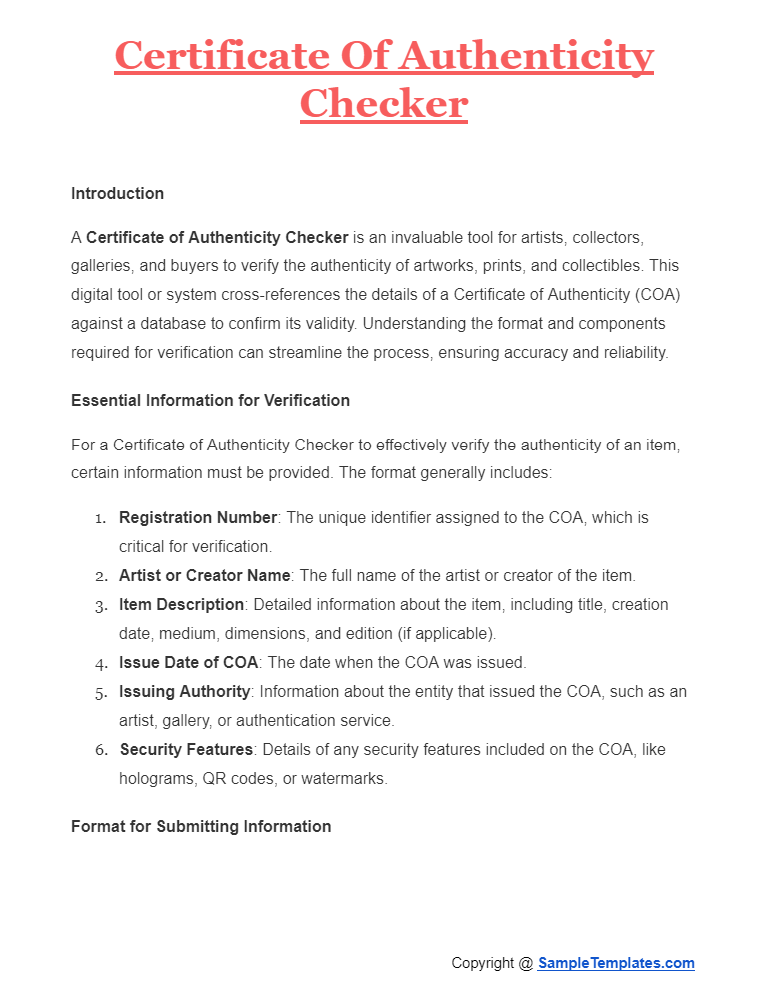
Browse More Templates On Certificate of Authenticity
1. Sample Certificate of Authenticity Template
2. Authenticity Certificate Painting Template
3. Authenticity Certificate Photography Sample
4. Authenticity Fine Art Prints Certificate Template
5. Authenticity Certificate With Photo Template
6. Simple Certificate Authenticity Artwork Template
7. Artwork Authenticity Certificate Template
8. Certificate of Authenticity Art Template
9. Creative Artist Authenticity Certificate Template
10. Modern Artist Authenticity Certificate Template
11. Authenticity Certificate of Artist Template
Where to Keep a Certificate of Authenticity?
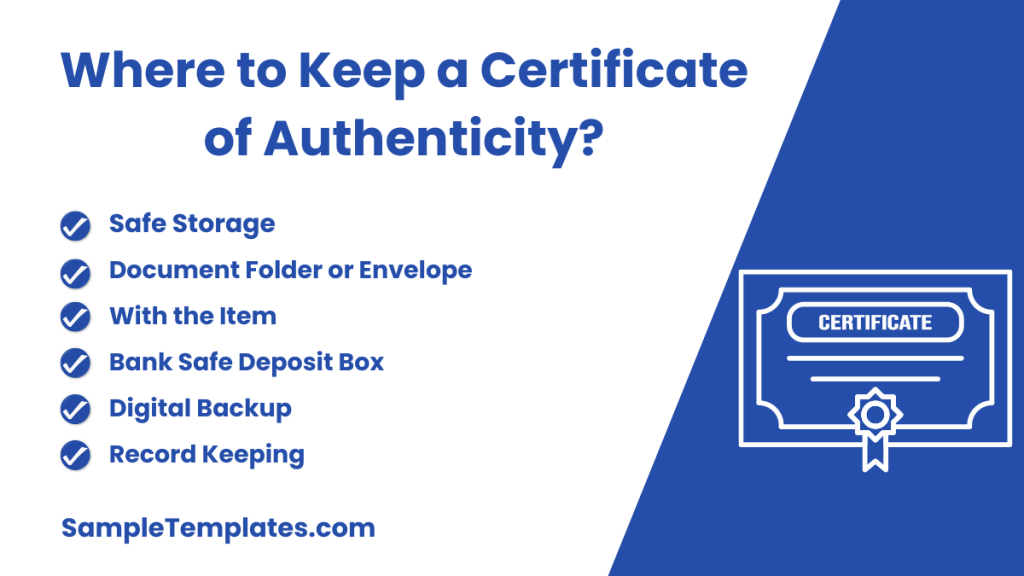
Storing a simple certificate of authenticity (COA) properly is crucial for preserving its condition and ensuring the value of the item it authenticates. Here are some suggestions on where to keep a COA:
- Safe Storage: A fireproof and waterproof safe is ideal for protecting COAs along with other important documents. This protects them from environmental damage and theft.
- Document Folder or Envelope: Use an acid-free, archival-quality folder or envelope to prevent the COA from deteriorating over time. Store this in a cool, dry place away from direct sunlight.
- With the Item: If the authenticated item is displayed, such as a piece of art, you can store the COA on the back of the item in a protective cover or envelope. For collectibles, keep the COA within the same display case if possible.
- Bank Safe Deposit Box: For extremely valuable items, storing the COA in a bank’s safe deposit box ensures maximum security and protection from home-related incidents.
- Digital Backup: Make a high-quality digital scan or photograph of the COA. Store the digital version in multiple secure locations, such as encrypted cloud storage and an external hard drive. This ensures you have a backup in case the original is lost or damaged.
- Record Keeping: For items with significant value or part of a collection, maintain a detailed record or inventory that includes the COA details. This can be stored digitally and/or in a physical ledger in a secure location.
Remember, the COA is as valuable as the item it authenticates because it proves the item’s authenticity and, by extension, its value. Proper care and storage of the COA are essential for any collector or owner of authenticated items.
12. Certificate Of Authenticity Photography Template
13. Free Blank Certificate Of Authenticity Template
14. Authenticity Certificate Template
15. Gems Authenticity Certificate Template
16. Editable Certificate Packages – in PSD, Word
What is Included on a Certificate of Authenticity?

A Certificate of Authenticity (COA) typically includes the following information to verify the authenticity of an item, especially in the context of art, collectibles, or designer goods:
- Title of the Work: The name given to the piece by the creator.
- Artist or Maker’s Name: The individual or entity that created the item.
- Date of Creation: When the item was made.
- Medium or Materials Used: The type of materials or medium utilized in the creation of the item (e.g., oil on canvas, bronze).
- Dimensions: Size of the item, often in height, width, and depth.
- Edition Number: If the item is part of a limited edition, the specific number of the piece within the edition and the total number of pieces produced.
- Location of Signature: Where on the item the artist or maker has signed, if applicable.
- Serial Number or Unique Identifier: A unique number that can be used to catalog or verify the item.
- Details of the Publisher or Manufacturer: For prints or manufactured collectibles, the name of the publisher or manufacturer.
- Authentication Statement: A statement sample or declaration that the certificate and the item are genuine, often including details about the authority or expert who verified the item.
- Date of Issue of the Certificate: The date on which the COA was issued.
- Issuer’s Name and Signature: The name and signature of the individual or entity issuing the COA, often the artist, a recognized expert, or a representative of a certifying body.
Certificates of Authenticity play a crucial role in establishing the provenance and legitimacy of an item, adding to its value and ensuring trust in its authenticity.
17. Certificate of Authenticity Template in Word
18. Authenticity Certificate Template in Word
19. Certificate of Authenticity Template
20. Authenticity Certificate Template in Doc
21. Product Authenticity Certificate Template
22. Simple Certificate of Authenticity Template in Word
23. Brand Authenticity Certificate Template
24. Artwork Authenticity Certificate Template
25. Certificate of Authenticity Template
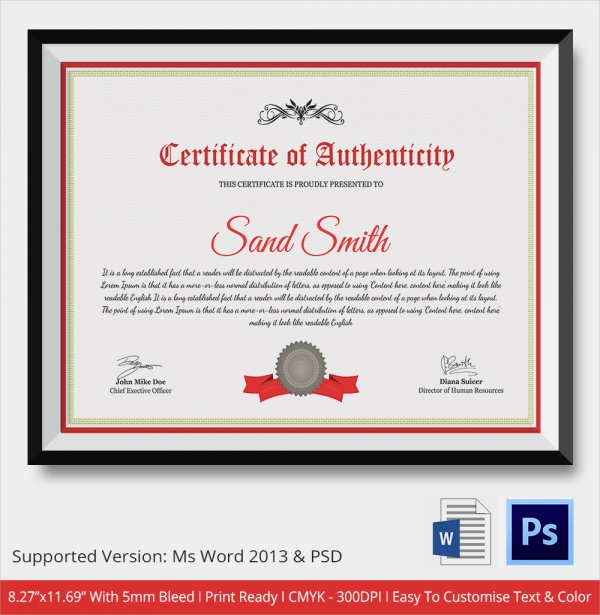
26. Award Certificate of Authenticity Template
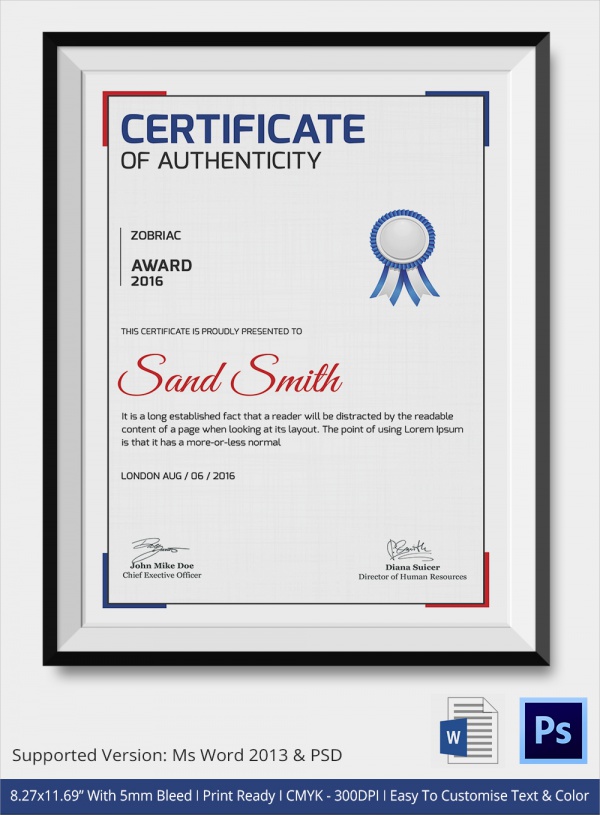
27. Amazing Certificate of Authenticity Template
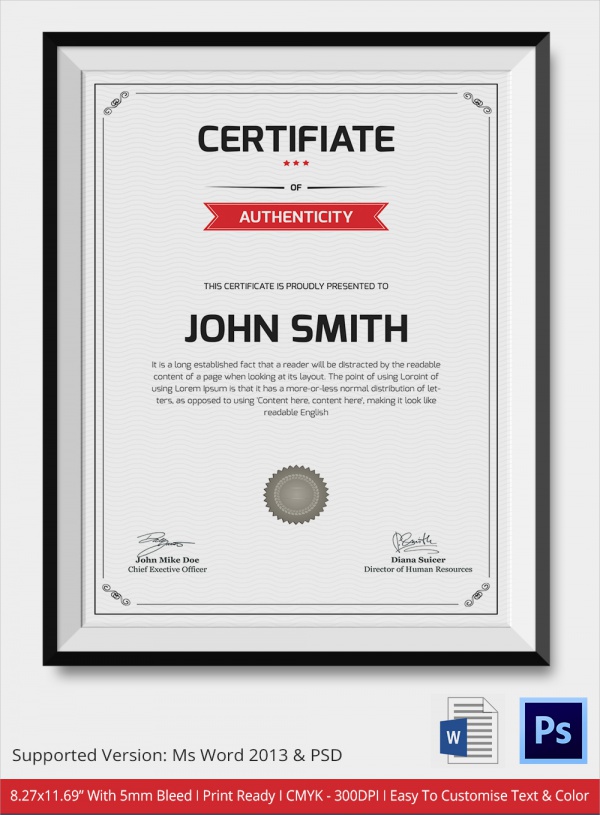
28. Sample Certificate of Authenticity Template

29. Editable Certificate of Authenticity Template
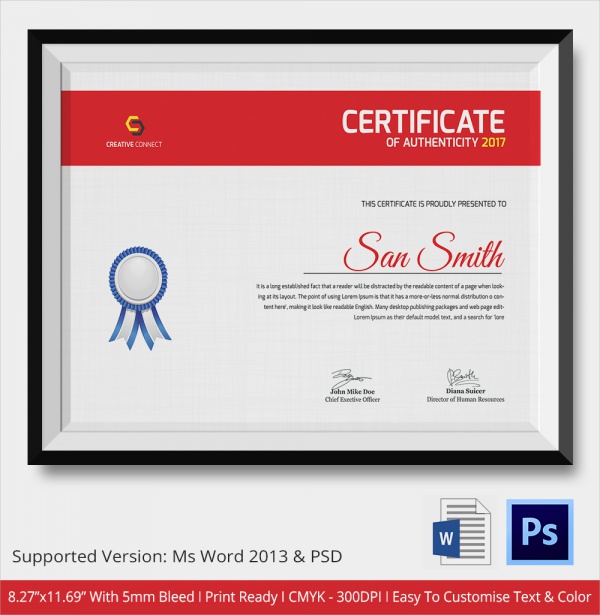
30. Beautiful Certificate of Authenticity Template
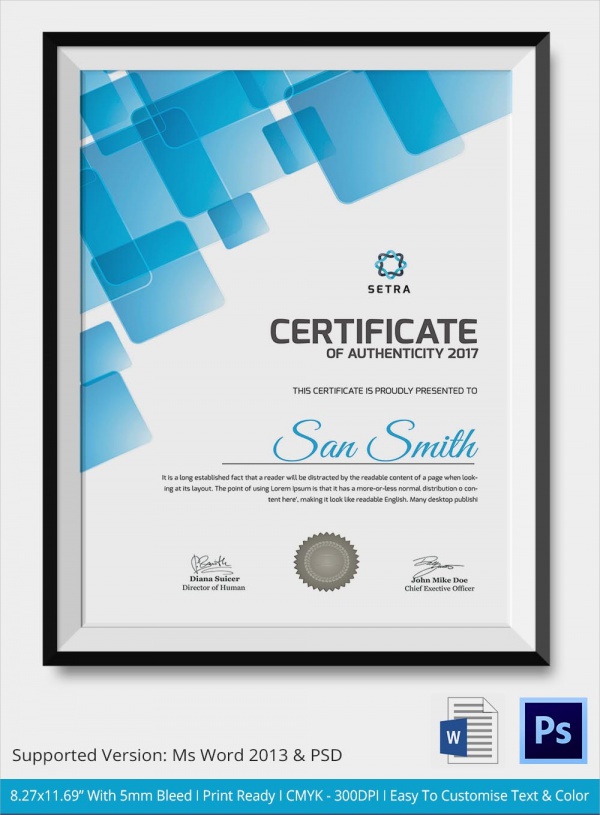
31. Certificate of Authenticity Template PSD
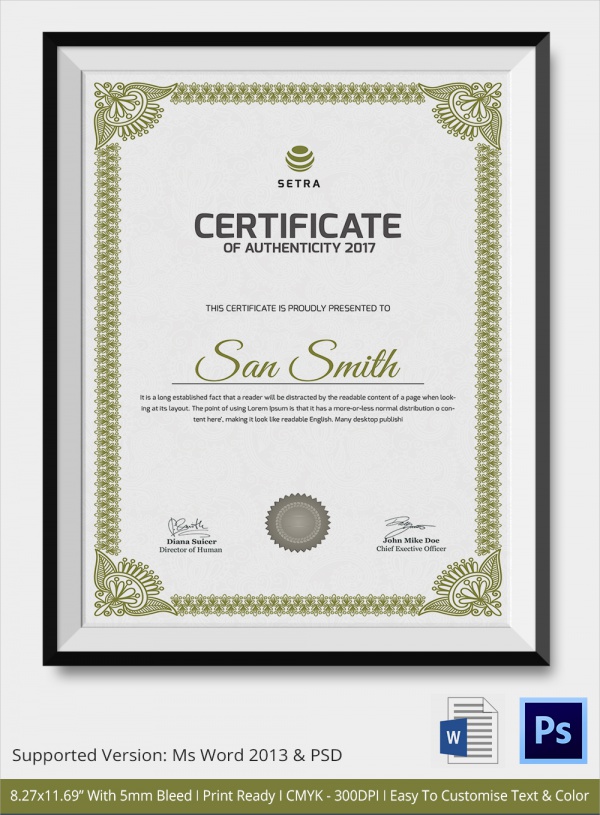
32. Beautiful Background Authenticity Certificate Template
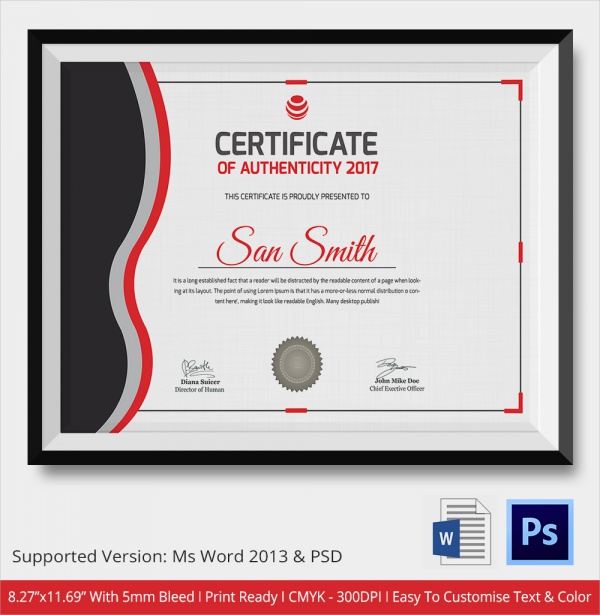
33. Purple Colour Authenticity Certificate Template
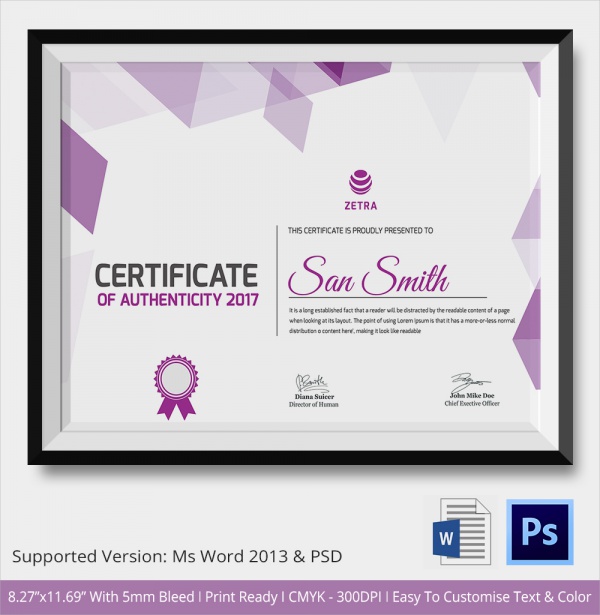
34. Multipurpose Authenticity Certificate Template

35. Award of Excellence Authenticity Certificate Template
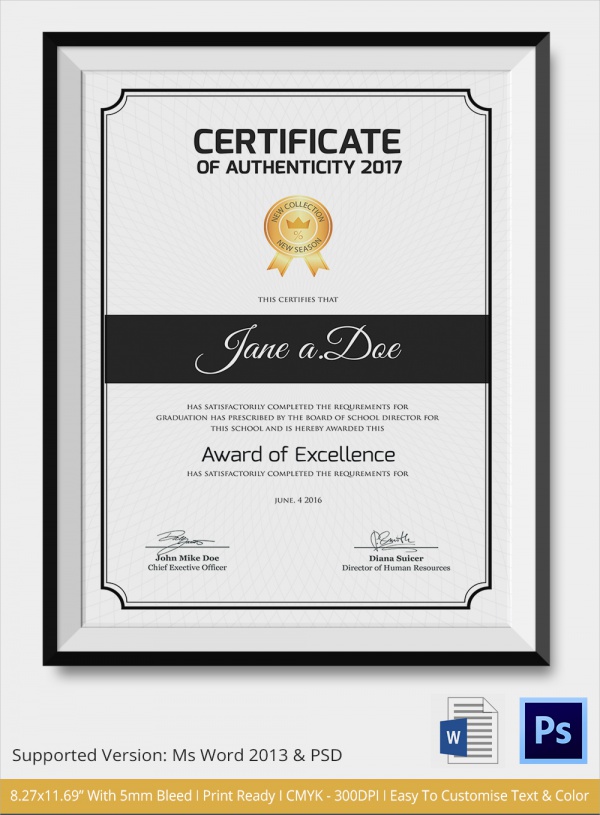
36. Certificate of Authenticity Example
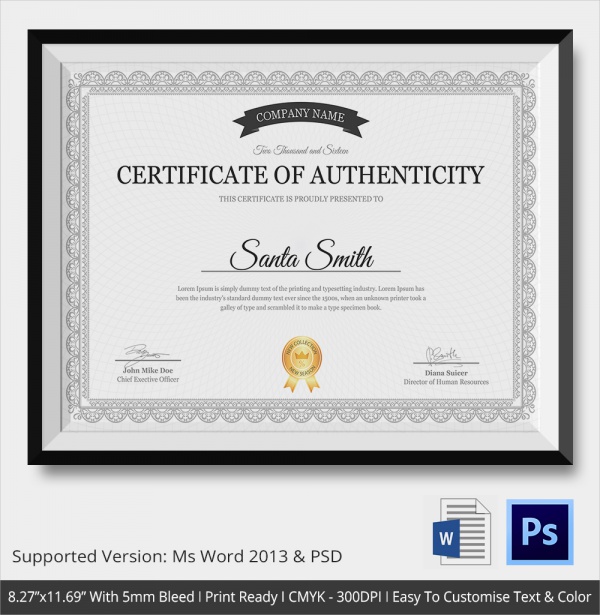
37. Customizable Certificate Of Authenticity Template
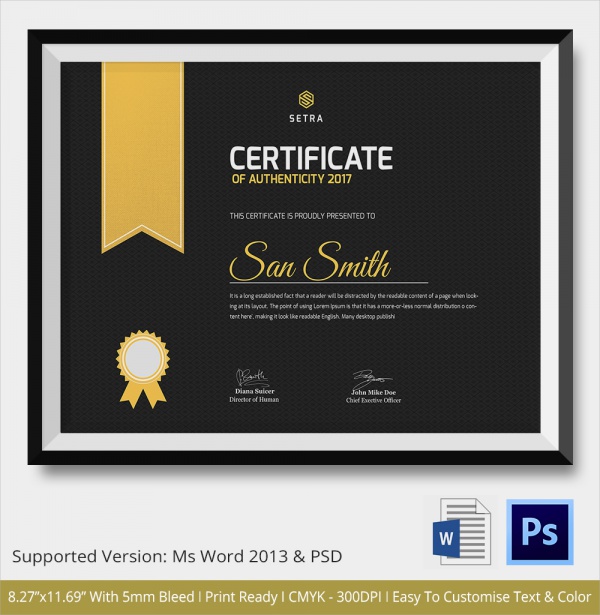
38. Universal Certificate of Authenticity Template
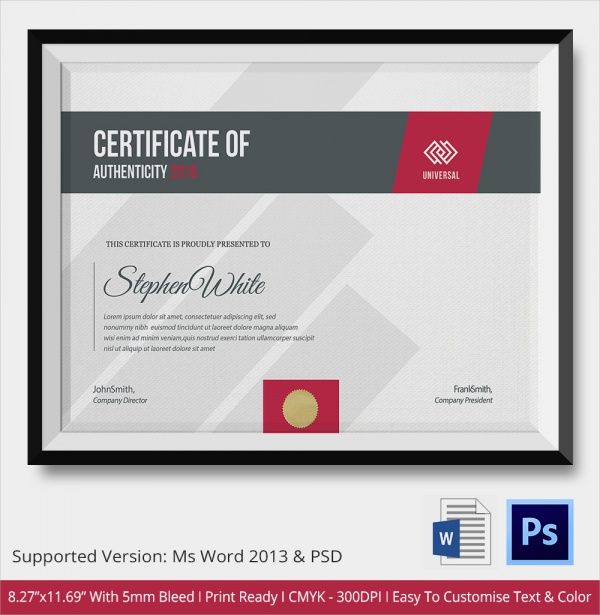
39. Company Name Authenticity Certificate Template
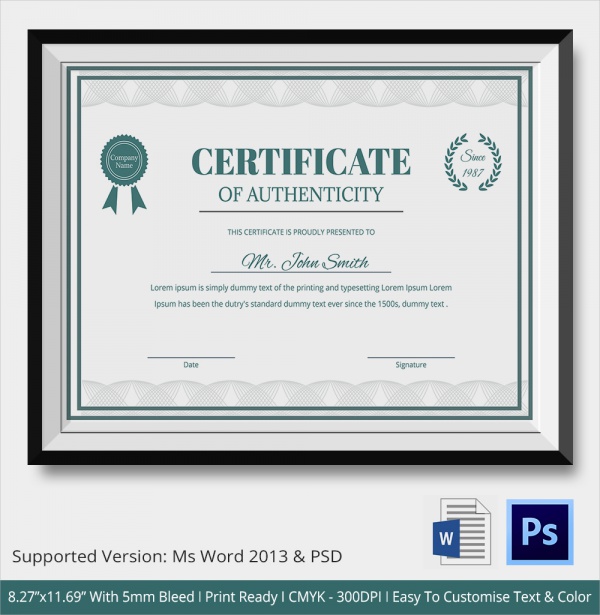
40. Authenticity Certificate Company Name Template

41. Employee Authenticity Certificate Template
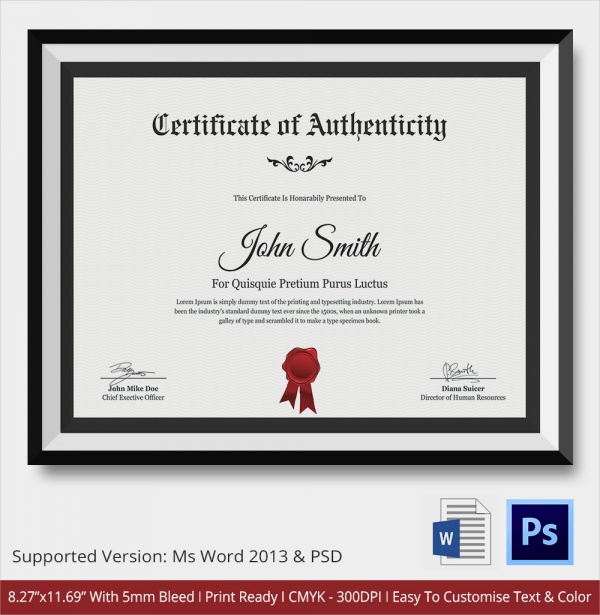
42. Certificate of Authenticity PSD
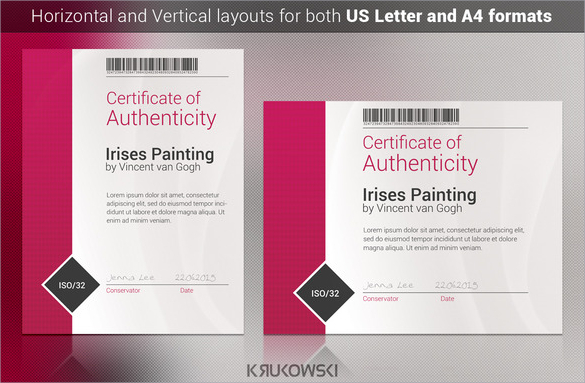
43. Printable Certificate of Authenticity Template
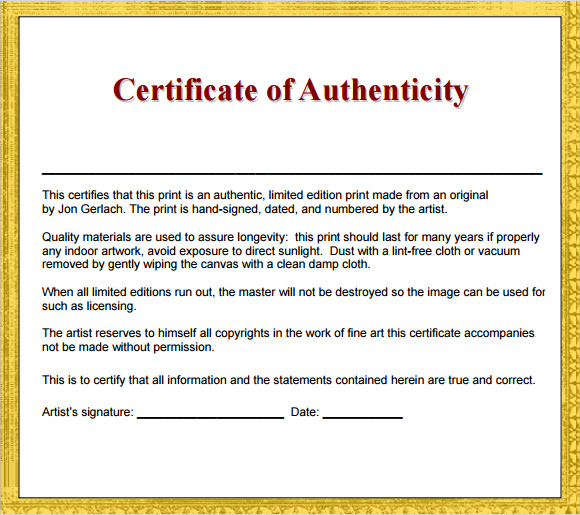
44. Certificate of Authenticity Wording Template
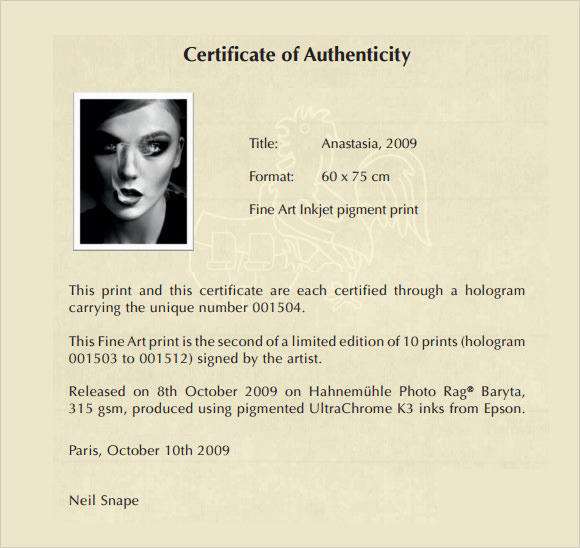
45. Business Certificate of Authenticity Template

46. Business Certificate of Authenticity Form Template
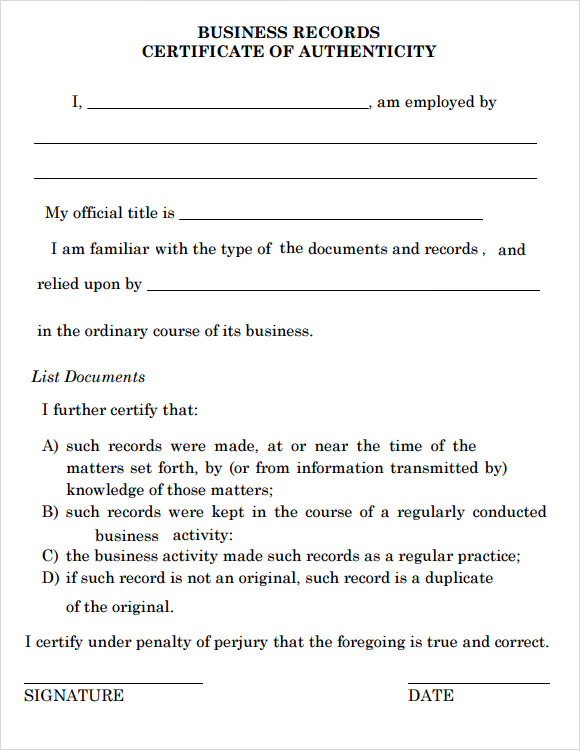
47. Sample Certificate of Authenticity Template
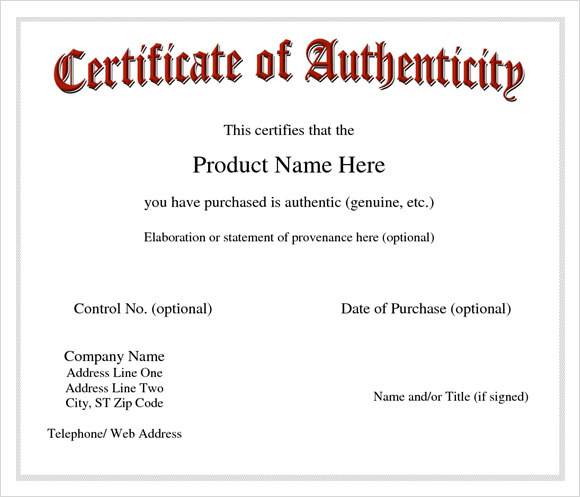
48. Certificate of Authenticity Template
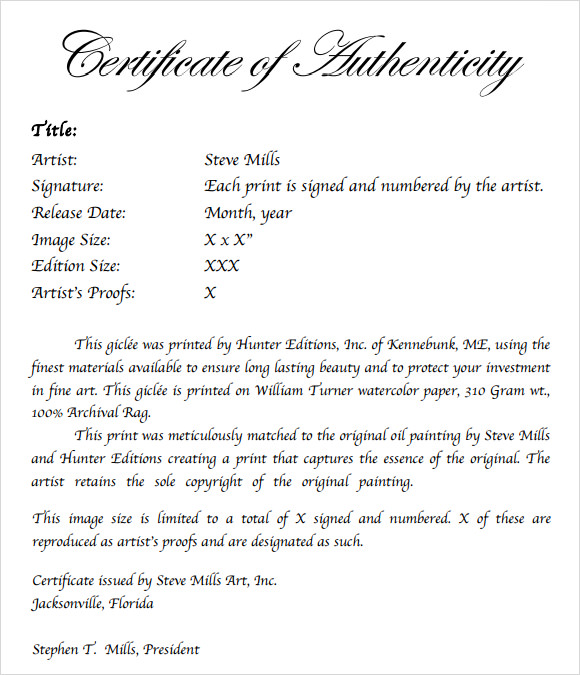
49. Sample Certificate of Authenticity Format

50. Printable Certificate of Authenticity Template
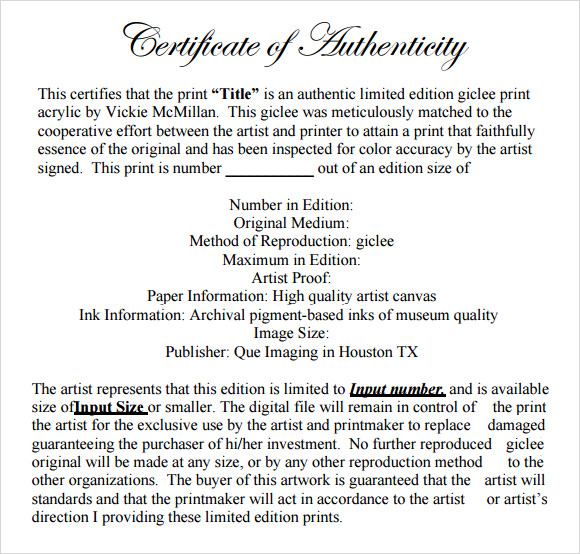
What Is a Certificate of Authenticity?
In simple terms, a certificate of authenticity contains specifications regarding the ownership of different artworks, significant hand-made items, and useful tools. With this document, the creator can provide invaluable information and proof of his or her part in the material’s production. Various artists use certificate templates to provide accurate information to the readers and audience.
With the digital age, anyone can easily manipulate files to lure individuals into thinking that the materials are original. According to an article from Forbes, art professionals have alerted the public about an influx of fake prints in the art industry. Now, unauthorized copies and reprints are hounding the viewers, and the experts encourage people to check the label and authenticity before making any purchase agreements. Forged prints not only cause distress to the original creator, but it also diminishes the credibility of the artist. Additionally, the maker will not receive proper credit and compensation for the sold artwork.
How To Make a Certificate of Authenticity
The certificate plays an essential role in making sure the actual creator or artist receives the proper credit for the work analysis done. This document is one of the ways to verify the legitimacy of the material. With that, here are the steps in making the certificate of authenticity for products and artworks.
1. Gather the Details of the Item
When making the certificate, you have to start by establishing the details of the owner. Use checklist templates to enumerate the vital information that should be in the certificate of authenticity. For instance, the name, method of creation, materials used for the work, and the number of editions must be included in the document.
2. Check Other Documents for Verification
Aside from the information gathered about the creator, you should also do a background check on the contents. You can research various newsletters to learn more about the artist. By confirming the information, you can assure that the certificate is necessary and accurate.
3. Choose the Font Style and Color
Next, you must focus on the graphic design of the document. After all, this certificate will be presented to different people and institutions. Hence, the design proposal should be appropriate and professional. You can check other certificate of authenticity templates to have an idea for the format.
4. Add the Institute or Organization’s Logo
And lastly, add the company logo of the gallery handling the creation of the certificate. By including the logo and gallery name, you increase the authenticity of the document. Additionally, other individuals need to see where the sample report came from for validation.
FAQs
How to get a certificate of authenticity for my artwork?
An art authentication certificate helps distinguish your publications from other artists. Whether it’s a photography collection or dozens of sculptures, you need to certificate of authenticity for artwork. You can acquire the document from art galleries that displays your scope of work of art. Every product you create should have a modern certificate of authenticity.
What is a letter of authenticity?
In a way, a letter of authenticity becomes a verification letter to the owner of the material. The letter serves as verified evidence for ownership claims of an artist or personality. More than the signature of the owner, the sample letter also includes essential information about the artwork or product.
Is the certificate of authenticity for original artworks difficult to acquire?
Getting the certificate will not be challenging if the artworks are displayed in a gallery. The establishment will verify your identity as the rightful owner of the material. With an artist agreement, you can secure the certificate of authenticity of the artwork. At times, you can also have the document by contacting a lawyer.
In this digitally enhanced modern society, almost anybody can claim ownership of various material posted online. With that, the original creators have to take extra precautions to protect the authenticity of their items. Whether it’s limited edition packages, a bunch of sports memorabilia, or jewelry, the owner should have a process documentation of authenticity as evidence of proprietorship. By reading the sample certificate of authenticity, the individuals will know the importance of getting one.
Related Posts
School Certificate Samples & Templates
Marriage Certificate Samples & Templates
Sample Medical Certificate for School
Sample Medical Certificate from Doctor
Sample Salary Certificate Templates
Project Completion Certificate Samples
Sample Medical Certificate Format
Sample Medical Certificate Forms
Training Certificates
FREE 32+ Sample Certificate of Appreciations in MS Word | PDF | AI | PSD
FREE 20+ Sponsorship Certificate Samples in MS Word | Google Docs | Pages | Publisher | PDF
FREE 19+ Resale Certificate Samples in PDF | MS Word
FREE 31+ Certification Samples in Google Docs | MS Word | Apple Pages | Publisher | PDF
FREE 28+ Sports Certificates in PDF
FREE 16+ Sample Football Certificate Templates in PDF | PSD | MS Word
